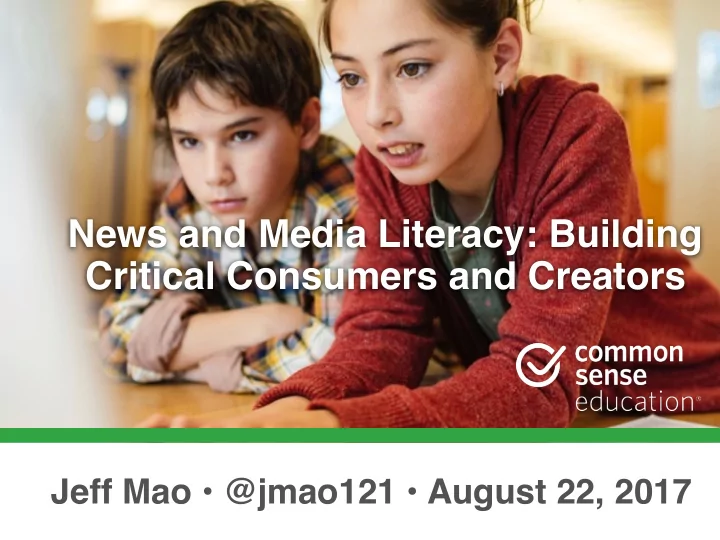

News and Media Literacy: Building Critical Consumers and Creators Jeff Mao • @jmao121 • August 22, 2017
Jeff Mao @jmao121 jeff.mao@makewonder.com Senior Strategic Education Outreach Manager Wonder Workshop • Senior Director, Education • Common Sense Education • Recovering Bureaucrat • Maine Dept, of Education • IT Director, Classroom teacher, coach, dorm parent • Maine School Administrative District 60 • Allendale Columbia School • Brewster Academy
Stanford History Education Group •Prototyped and field-tested 15 assessments (middle school, high school, college) •Analyzed 7,804 student responses •Focused on civic online reasoning https://sheg.stanford.edu/upload/V3LessonPlans/Executive%20Summary%2011.21.16.pdf
Homepage Analysis Can Middle School Students Differentiate Between Ads and Editorial Content? ! 75% of students correctly identified traditional ad and the news story. ! 82% of students believe the native advertisement, identified by the words “sponsored content” was a real news story. • Students even mentioned that it was “sponsored content” but still believed it was an article. https://sheg.stanford.edu/upload/V3LessonPlans/Executive%20Summary%2011.21.16.pdf
Evaluating Evidence Can High School Students Determine Source and Legitimacy of Information? ! “Students across grade levels were captivated by the photograph and relied on it to evaluate the trustworthiness of the post.” ! 40% argued the post provided strong evidence of toxic conditions near the nuclear plant, even though no source or location was given for the photo. ! 25% of students argued the post did not provide strong evidence (but only because it did not show other plants or animals that may have been affected by radiation) https://sheg.stanford.edu/upload/V3LessonPlans/Executive%20Summary%2011.21.16.pdf
What Can We Do?
http://www.MediaEducationLab.com
First steps • Consider a Browser Extension • Use Fact Checking Sites • Buy the Newspaper (online)?
Five Key Questions Form Foundation for Media Inquiry Center for Media Literacy Core Concepts Key Questions Authorship All media messages are Who created this message? “constructed.” Format Media messages are What creative techniques are used to constructed using a creative attract my attention? language with its own rules. Audience Different people experience the How might different people understand same media message this message differently from me? differently. Content Media have embedded values What lifestyles, values, and points of and points of view. view are represented in, or omitted from, this message? Purpose Most media are organized to Why is this message being sent? gain profit and/or power. http://www.medialit.org/reading-room/five-key-questions-form-foundation-media-inquiry
Five Key Nuances of News Literacy Center for News Literacy ! Recognize t he difference between journalism and other kinds of information and between journalists and other information purveyors ; ! In the context of journalism, recognize the difference between news and opinion ; ! In the context of news stories, analyze the difference between assertion and verification and between evidence and inference ; ! Evaluate and deconstruct news reports across all news media platforms, based on the quality of evidence presented and the reliability of sources; ! Distinguish between news media bias and audience bias . http://www.centerfornewsliteracy.org/what-is-news-literacy/
4 Tips!!
•Model and encourage “lateral reading” • Think like a Fact Checker • Read about the story Tip #1 or issue from multiple sources • Rather than trust the “about” section of the site, research the org and author
• Teach about how the system works, not just how to use the system • How search rankings work (not based on trustworthiness) Tip #2 • Spotting online ads & sponsored content • Search algorithms • Filter bubbles > Echo chambers
• Encourage students to think like reporters and create their own news. Tip #3 • To be a critical consumer, one must also be a creator
• Weave in information literacy, media literacy, and news literacy into the curriculum. Tip #4 • Common Sense provides teaching and curricular resources (free)!
News & Media Literacy Toolkit https://www.commonsense.org/education/toolkit/news-and-media-literacy
Common Sense Education https://www.commonsense.org/education/toolkit/news-and-media-literacy
Teaching Strategies: Curated resources to support educators https://www.commonsense.org/education/teaching-strategies/turn-students-into-fact-finding-web-detectives • Articles • Videos • Posters • Research
Additional Resources Organizations / Sites Detecting Fake News How to Spot Fake News - Factcheck.org, 2016 National Assoc. for Media Literacy Education 10 Ways to Spot a Fake News Article News Literacy Project Easy Bib, 2017 Fake Or Real? How To Self-Check the News and Get the Center for News Literacy Facts NPR, 2016 The Smell Test: Educators can Counter Fake News SchoolJournalism.org School Library Journal, 2017 Can You Spot the Fake US Election News Stories? The Lamp The Guardian, 2016 (QUIZ) In an Age of Fake News, Teaching Media Literacy + Quiz Project Look Sharp Providence Journal, 2016 A News Literacy Toolkit for a “Post-Truth” World Media Literacy Now School Library Journal, 2016 PolitiFact's guide to fake news websites and what they peddle Mind over Media - Analyzing Contemporary List of known Fake News sites Propaganda https://studentreportinglabs.org/ Digital Tools PolitiFact.com FactCheck.org Snopes.com Tribeworthy Fake News Alert | Stackup | This is Fake - Chrome Common Sense Education Extensions
Jeff Mao @jmao121 jeff.mao@makewonder.com
Recommend
More recommend